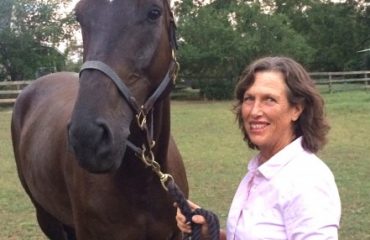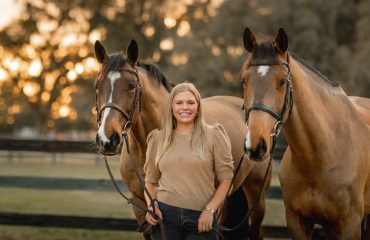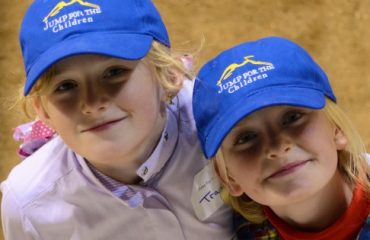By Juliana Chapman
Portraits by Kirsten Hannah
“There is no quick fix when it comes to horses,” said Samantha Wolfram, a 22-year-old equestrian professional. “You can’t flip a switch and the horse comes out broke and is easy to ride.” For most equestrians, this statement is a testament to the grit and reality of the horse business—there are no easy roads to establishing your career. But for Samantha, using her risk-taking, talent and ambition while riding and living abroad is helping set her up for success.
Growing up an only child in Elkhorn, Wisconsin, Samantha received her first pony at the age of 2 thanks to her mother, who was a horse trainer. “My mom got me a pony like what you see at the fair. However, he was a bad pony—or what I like to call ‘character building,’” she said. Her early start riding was a gift unto itself and by 5, Samantha was jumping crossrails. She was committed to riding until the age of 8, when another sport became her focus. “I was at an age where I wanted to fit in, and being a crazy horse girl did not help with being popular,” Samantha shared.
The strong-willed pre-teen dabbled in gymnastics—which she admits she was terrible at—because she didn’t want to do anything her mother wanted her to do. But then she started thinking about getting back into riding, and by 14 she got her first horse. “Otis was a 4-year-old and became another character-building experience,” she said. “He was badly behaved and naughty all the time. He wasn’t a fancy horse, but I don’t think I would be a decent professional if I didn’t have that experience.”
Samantha ended up competing successfully in the 3’6” Junior Hunters and qualified for Junior Hunter Finals but had to work hard to pay off her monthly board and be able to continue to ride. “My family couldn’t afford to go—so I didn’t end up going,” she said. “I graduated a half year early from high school with college credits because the only way my parents would let me continue with horses was if I had a 4.0.”
Her work ethic and determination led to greater things. “My horse got leased out when I was 18 so I could go to Europe. After four years of him challenging me both in an out of the saddle, it was rewarding to see him turn into a nice children’s hunter,” she shared.
An Opportunity Abroad
While Samantha was struggling with her path in life, a Facebook message changed everything. “I got a message about an opportunity to ride in Belgium,” Samantha said. The message left her with the decision whether to attend Marquette University in Milwaukee or answer yes to Belgium. “This totally stressed me out because my parents didn’t want me to be in the horse profession, but this is what I was passionate about and it was either spending a lot of money on something I really didn’t want to do or take a leap of faith and live and ride in Belgium. Like a crazy person, I chose Belgium.”
 With $500 in her bank account, Samantha lived in Belgium for three months on a tourist visa, which allows one to travel back to their homeland two times—giving a total of six months to live abroad.
With $500 in her bank account, Samantha lived in Belgium for three months on a tourist visa, which allows one to travel back to their homeland two times—giving a total of six months to live abroad.
“I worked for horse breeder and trainer Don Leys in Lier, Belgium, and Jessica Hengen, owner of European Sport Horses Imports,” Samantha said. Don, who splits his time between being a breeder and a dealer, and Jessica offered Samantha a job allowing her to get a professional card to stay in the country and work. “It’s tough to get an equestrian job there because there are so many riders that live in Belgium, and you have to prove that you can bring something to the table,” she explained. Samantha used the American angle—as an American rider, her advantage was she could help sell horses to the lucrative U.S. market.
“The culture shock of living in Europe is crazy—with the language barrier, not knowing anyone, and the riding being so different—you honestly think you are the worst rider in the entire world,” she said. The doubts soon crept in as Samantha reeled from her decision—was this a mistake?
During her time living there, at least 10 girls were part of the working student exchange program. “Every few months, another American working student would come in.” Many would turn right around and literally leave in the middle of the night. “I’m still in contact with the working students—even the ones who left. I totally understand why they did what they did. I didn’t have that choice because I left everything behind, and I didn’t have a backup plan. I was forced to make it work.”
Samantha lived on the stable property and would begin her day around 8 a.m. with feeding followed by a coffee break. “They are big coffee drinkers—Don and I would make a plan for the day over coffee,” she said. Between exercising up to 10 horses, making sale videos and traveling the country to try horses, her days were full. “We would drive all around Belgium, France, the Netherlands and sometimes Germany to shop for horses. If Don was interested in them, he would bring them in to keep for a month or so and I would get a chance to ride them.”
Samantha said riding is more difficult and raw in Europe versus the U.S. “You start the horses from scratch, trying to install the buttons so when they come to America, they are more user-friendly,” she said, dubbing them the ‘pre-America version.’ “Part of my job was not only making sales videos but training horses to become hunters because they don’t have hunters in Europe.”
Another difference is that it’s much more expensive to develop horses in America than in Europe. For Europeans, horse ownership is more a way of life than an elitist sport. “You can develop them for less and then sell them in America to make a profit,” she said.
Back in the States
Samantha learned a lot about horses, life and more from one of her early trainers, Cassie Jarchow at Rising Star Stables in Wisconsin. “She really made me the horse professional I am today,” she said. “I would let my emotions get the best of me and react to situations impulsively, and Cassie taught me how to handle those situations and say the things that needed to be said and not say the things that didn’t.”
Cassie also developed Samantha’s depth of riding. “She lent me one of her horses and I rode in the Medium Junior Jumpers to give me experience in the jumper ring,” she said. “At the time, I owned a hunter and I wanted to show regardless—so this arrangement helped expand my knowledge with jumpers. I love the jumpers; it’s more like a sport, and I feel like the hunters is more like an art.”
Another of Samantha’s mentors was Don Leys, the person who encouraged Samantha to stay in the horse business and make it her career. “Still to this day, Don is someone I can turn to for advice—he’s like my boss but is also a father figure to me. He’s realistic with setting limits and expectations,” she said.
Samantha feels that it’s refreshing to have someone be honest with you. “Europeans tend to be more realistic—there is no sugar-coating things and not everyone can be on the team. It was very eye-opening—and jarring at first,” she said.
For the last two Florida circuits, Samantha has been in the irons representing Paige Cade from Middleburg, Virginia. It was full circle with Paige, Samantha shared. “She has a sales barn and tried horses in Europe that she brought to the U.S.—those horses I ended up showing during circuit and selling them,” Samantha said.
One of Samantha’s favorite horses to date is Pinot, a 16.1-hand gray Italian Warmblood imported from Belgium. “I rode him in the International Derbies over the last two years and I found his jumping technique unmatched—he is so special. Pinot is owned by a Junior; however, he had anxiety in the show ring and the family that owned him agreed that they would let me show him for a while.”
Samantha said the journey with Pinot helped her grow. “When I first rode him, I couldn’t get a consistent result but we worked through it and the last circuit, we moved up to the High Performance including the 3’9” Greens and did well,” she said. She also showed at the World Equestrian Center and got third in an International Derby up against some of the best.
Riding Challenges and Rewards
For Samantha, the mental aspect of riding is challenging. “Sometimes if I could just remove my brain, I’d be a lot better at riding,” Samantha laughed. She shared that she had a bad fall during circuit and getting on a horse after that, even though she knew it was an accident, made her second guess everything. “Whether you are in a competition with yourself or with other people, you see these 18-year-olds going around the five-stars winning, which makes you question—should I choose a different career path?”
Samantha values learning and utilizing the skills she has learned in Europe and on American soil. “I’m building up my business and reputation in the sales industry. That includes bringing up to six horses from Europe to the World Equestrian Center every year and selling them,” she said.
“My number-one goal with horses is to be sustainable for the long term. I like the sales aspect. There is the scouting aspect and then there is the riding aspect—I want to be the best rider I can be in addition to making smart financial decisions to build a career and a hobby. It must be a job first and a hobby second, but eventually I’d like it to be more half and half!”
Follow Samantha on Instagram @samanthawolfram
Photos by Kirsten Hannah, kirstenhannahphotography.com















